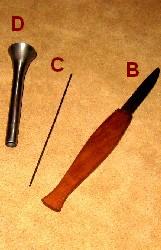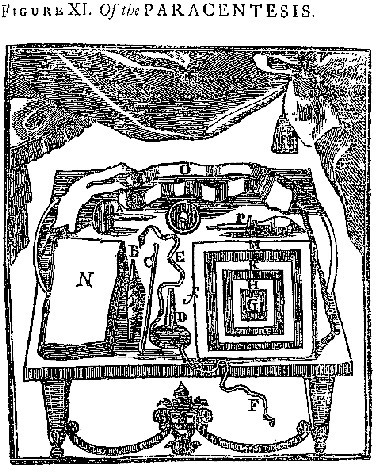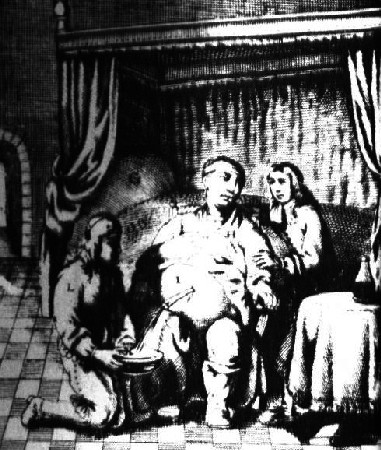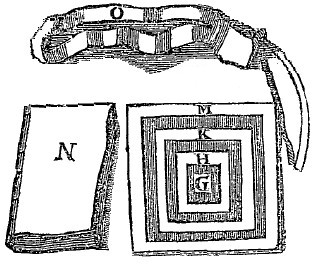
Dropsy Treatment with Scarifier and Trocar Pages: 1 2 3 4 Next>>
Dropsy Treatment with Scarifier and Trocar, Page 3
Of the two non-scarifying methods for treating dropsy, Dionis idenitifes two methods. The first is a rather long and complicated ancient method using lancets and bandaging. The second is a fairly straightforward 'modern' (for the early 18th century) method using a tool called a trocar. This page features the complex lancet method and the next page shows the modern method.
Preparing for the Ancient Method Using Lancets

Mission's Tools - as
mentioned in the text
"First of all, in this Operation, as well as all others, the Chirurgeon
must dispose his Apparatus, which consists of proper Instruments,
Plaisters [a medicated bandage], Bolsters [pieces of cloth], and Bandages,
such as you see rang'd on this Plate. The Instruments are three, a
Lancet, B, a Probe, C, and a Tube or Pipe
D; the Lancet ought to be like those used in Phlebotomy, that is small , that
it may not make the Aperture too large: Its Blade is wrapp'd about with a
narrow Linen band, no more being left uncover'd than what is necessary to
penetrate as far as the Water. The Probe is a small long Silver Style, like those
used in probing of Wounds: It must be slender enough to pass through the Cavity of
the Pipe, which should be of Lead or Silver qualified as follows, viz. first,
well polish;d, that it may not hurt; secondly, to have a Rest or Stay at its Head,
lest it advance too far in the Cavity; thirdly, as to be bor'd through its whole
length, and pierc'd on its sides; fourthly, not to be so long as to touch the
internal Parts; fifthly, to be provided with two small Holes at its Head through
which to run the Ribans, E, F, which keep it from coming out; sixthly, to be proportioned
to the Instrument with which the Punction is made; for if it were bigger, it could not
enter; and if less, the Water would escape betwixt it and the edge of the Wound.
The Apparatus being ready, the Patient must be placed: Some Chirurgeons fix him
on his Seat in his Bed, and others oblige him to rise, in order to seat him in an easy
Elbow-Chair:

Figure X: Of the Paracentisis - Tools for Treating Dropsies
(M. Dionis, p. 69)
This last Situation is the most advantageous; for besides that the water will
run, without Interruption, into a Vessel plac'd on the Ground betwixt the Patient's
Legs, we don't run the risque of spilling the Water in the Bed, which ought to be ready
disposed to receive the Patient immediately after the Operation, he then wanting Repose.
Next, the Chirurgeon takes up the Patient's Shirt to uncover his Belly, and with
a little Ink marks the Place where he intends to pierce. Authors tell us, that it ought to be
four Fingers below, and on the side of the Navel in order to avoid the Aponeurosis
[layers of flat broad tendons], and make the Punction in the Body of the Muscles of the
Abdomen: But if, when the Belly is tumefied [swollen] and full of Water, the Operator
should leave but four Fingers betwixt the Navel and the Place to which he applies the Point
of his Lancet, the Puncture would undoubtedly fall amongst the tendinous Expansions; for the
greater security 'tis then necessary to perform the Punction seven or eight Fingers breadth
on one side, or below the Navel, and the Chirurgeon will find that after the Belly is emptied and
returned to its normal State, it will not be above four Fingers breadth from the middle of the
Abdomen, and this is supposed to be the meaning of the Chirurgical Writers.
...
Since by this manner the Incision separates only the Fibres of the transverse Muscle
without cutting them, and when the Chirurgeon comes to take out the Pipe, the approach one
another, and re-join the Lips of the Wound of the Peritonæum which is adherent to them,
which advances the cicatrizing."
(Dionis, p. 81-2)
The Procedure of Operation for Dropsies with Lancets
The Circumstances to be observ'd during the Operation at these: A Servant ought to be
placed behind the Patient, that resting with his Hands on the two lateral parts of the Belly,
he may push outwards the part which is to be prick'd, and prevent the point of the Lancet
touching any of the contained Parts. After this the Chirurgeon takes in his right Hand the
Instrument which he plunges across, 'till it has pierc'd the [?] Muscles: When he
makes a little pause, then with the other Hand drawing the Skin a little downwards, he finishes
with thrusting the Lancet as far into the Cavity; and when, by the Water issuing out on both
sides of the Blade, he discerns that he is entred, he takes the Probe in his right Hand,

Relief of dropsy, from Paul Barbette
Opera Omnia Medica et Chirurgica (1672)
and
introduces it into the Abdomen by the assistance of this Blade which serves him as a Guide;
then withdrawing his Lancet, and having given it to some Boy, he receives in the same Hand
the Tube or Pipe, in the Cavity of which he trusts the end of the Probe, and after having
chang'd his Hand, he pushes with a little violence 'till 'tis entred the
Cavity: When drawing out the Probe he sees the Water run out at the exterior Aperture or the
Pipe, in the same manner as Wine does out of a Hogshead just pierc'd and tapp'd
with a Cane.
'Tis not in vain that I told you the Belly must be pierc'd at twice, and that the Skin must be a little lower'd for by this means the wound not being entirely straight, it's Aperture will be stopped by the Skin which was drawn down, and the incision be very much expedited. When the Tube is taken out, care must be taken not to fall into the fault committed by the Chirurgeon at Monfert, who performing this Operation on the Wife of one of the King's Officers, and endeavouring to introduce the Pipe, negligently quitted the Probe, which sliding in to the Cavity of the Belly, could not be drawn out before the Death of the Patient; and tho' this Accident was not the sole Cause, yet the People, who don't always take Things right which are not obvious to the Senses, imputed it to that: The Chirurgeon must not then quite the Probe in changing one Hand, 'till he is very sure he has fast hold of it with the other.
The quantity of Water to be drawn out this first time is not prescrib'd. The Chirurgeon regulates himself according to the strength of the Patient; he may evacuate two, three or four Pints; and if we should hearken to the Patients we should draw off more, because they find themselves eased in proportion to the quantity which runs out, and respire more freely. But in this follow the Advice of good Practitioners, who forbit us the emptying of the Belly all at once; and really 'tis better to do it in three or four Times, than to precipitate all at once from an extreme Repletion to an extreme Inanition, because violent an immeasurable Evacuations are Mortal; and, in general, every Excess is an Enemy to Nature, which proceeds slowly and by degrees. During the running out of the Water, the Operator may give the Patient a small quantity of Wine, or some other Liquor [fluid], to prevent his Fainting; and when a sufficient quantity is evacuated, he stops the hole of the Pipe with a small Stopple of Lint, F: Two or three Days after the Chirurgeon returns, and barely taking out the Stopple, lets out as much Lympha as he thinks proper, and continues to draw out the Water at several Times, 'til the Belly be entirely drained of these exotic Serosities.

Figure X: Of the Paracentisis - Tools G - O
(M. Dionis, p. 69)
But immediately after the first Evacuation, the Cavity of the Pipe being stopp'd, the Chirurgeon must
apply a square Plaister G, charg'd with Astringent Medicament, and cover it with a Bolster H,
which extends a little beyond each of the Edges; that done, a second Plaister I, of the same shape
is clapt on, and another Bolster K, above it; after which, the whole is covered with a yet larger and
third Plaister L, and lastly a great Bolster M, which strongly presses the place of the Aperture. These
Plaisters and Bolsters are sustain'd by the Napkin N, of which is made a circular Bandage, sustained
by the Scapular O:
This done, the Patient is next again put to Bed, taking care that he be not suffered to lie on that side in which the Punction was mad, for fear lest the Water should force out the Stopple, and unreasonably run out, or else evacuate in such large quantities, as to put the Patient in danger of his Life." (Dionis, p. 82-4)

